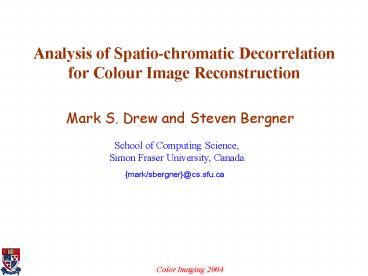Analysis of Spatio-chromatic Decorrelation for Colour Image Reconstruction - PowerPoint PPT Presentation
1 / 27
Title:
Analysis of Spatio-chromatic Decorrelation for Colour Image Reconstruction
Description:
Analysis of Spatio-chromatic Decorrelation for Colour Image Reconstruction Mark S. Drew and Steven Bergner School of Computing Science, Simon Fraser University, Canada – PowerPoint PPT presentation
Number of Views:136
Avg rating:3.0/5.0
Title: Analysis of Spatio-chromatic Decorrelation for Colour Image Reconstruction
1
Analysis of Spatio-chromatic Decorrelation for
Colour Image Reconstruction
- Mark S. Drew and Steven Bergner
School of Computing Science, Simon Fraser
University, Canada
mark/sbergner_at_cs.sfu.ca
2
I. Overview
- Use of PCA vs. ICA whats the difference? -
How do you do ICA? - What does this have to do
with images? - The objective best characterize
image blocks using ICA on color image block data
spatio (blocks are 16x16, say)-chromatic (x3)
assign bits in bit allocation according to the
importance of each ICA coefficient ? data
compression.
3
Best characterize image ? colour and spatial
information. Colour we think of using PCA
(Principal Component Anaysis) discover main
colour axes. Is this best, given our
objective? Spatial use spatial Fourier filters?
Gabor wavelets? Etc. Here, well use ICA
(Independent Component Anaysis) to derive best
colour and spatial decomposition at once, for
decorrelation, compression, and reconstruction.
4
II. ICA ? What is it?
ICA is a form of Blind Source Separation ? To
explain, consider audio signals (in an Imaging
conference!). Consider 2 speakers, and 2
microphones
s2
s1
x2
x1
-sources
-data
5
Can we disentangle s1, s2 from measured data x1,
x2 ? The cocktail party problem.
An example
6
ICA
7
What about PCA?
?
Writing the signals in terms of reduced set
of sources s1, s2, s3, . . ., for
higher-dimensional data, we can do a better job
in compression.
8
III. ICA ? How to do it?
(x was 2xN in the audio example.)
Model
9
Driving idea for finding sources s1, s2 are
statistically independent information about
one gives no knowledge re. the other.
Not just uncorrelated covariance 0
PCA
10
If independent as well, the pdf is separable
marginal pdfs
which implies
11
So, to do ICA, start with uncorrelated signals
(using PCA) simplifies.
Main tool Non-Gaussian is independent.
Central Limit Theorem the sum of two
independents is more like a Gaussian than is
either one.
So ? we have sums . To get s,
make a linear combination of xs that is as
non-Gaussian as possible.
12
One way (many others) A Gaussian has zero
kurtosis.
For zero mean y,
Rescale y to variance1
? just use
We seek a signal that maximizes kurtosis.
13
Algorithm ? whiten the data zero mean,
linear transform to make uncorrelated, variance1.
First, PCA orthogonal U with
In the new coordinate system,
Why? ? Now
with orthogonal
? simpler to search for.
14
Algorithm
- whiten x
- -we seek a column w of orthogonal W, with
, - that maximizes kurtosis
Euler eqn.
1. Initialize w randomly, with
2.
3. 4. stop when
Code
15
Matlab
16
IV. ICA for Images
Previous work
Greyscale and colour imagery using PCA and ICA
. For colour images, x could be 3-vector
pixels. But get spatial as well if use n ? n
tiles (nice illustration in Süsstrunk et al.,
CGIV04 using PCA on raw CFA data) We show
here that compression is better using
ICAcolourspatial info.
17
ICA (162x1 greyscale data)
16 x 16 greyscale tiles
ICA finds sparse features
localization in space
18
With colour
PCA vs. ICA (3x1 data)
(no spatial information)
19
PCA vs. DCT (4x4 x3 data)
- Colour luminance,
- blue-yellow, red-green
20
PCA vs. ICA
21
ICA (4x4)
ICA (5x5)
ICA (8x8)
ICA (16x16)
22
Colour vs. Greyscale ?Compression? performance
Greyscale
Colour
(Generic basis)
- Higher reconstruction quality (SNR) for larger
patches - Colour has better quality than grey, at
equal compression
23
ICA vs. PCA
(Specific basis image )
PCA
ICA
- ICA much better than PCA higher compression
for same SNR - ICA ?increased quality with larger
patches, for equal compression
24
ICA vs. PCA
- ICA does better separating axes such that they
influence each other least - ? better entropy coding
- Colour aids in compression
- Large patch sizes and low rate encoding ? At
equal compression, SNR (quality) better for ICA
25
ICA vs. PCA Image reconstruction (compression
ratio 112)
26
Another image
? 71
DCT PSNR 31.40
ICA PSNR 39.69
27
The Future Video Bases submitted































